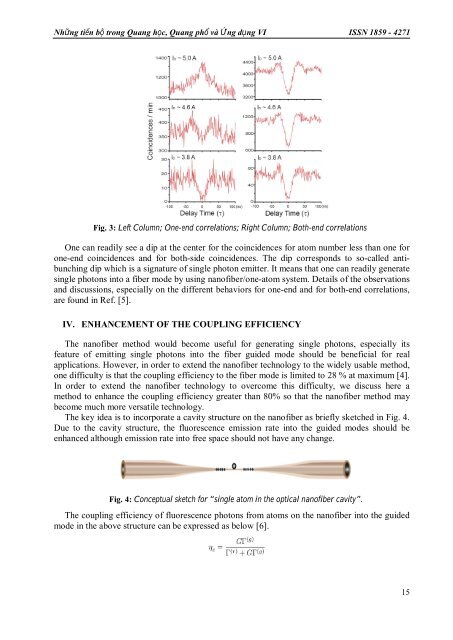Nhng tin b trong Quang hc, Quang ph và ng dng VI ISSN 1859 - 4271
Nhng tin b trong Quang hc, Quang ph và ng dng VI ISSN 1859 - 4271
Nhng tin b trong Quang hc, Quang ph và ng dng VI ISSN 1859 - 4271
You also want an ePaper? Increase the reach of your titles
YUMPU automatically turns print PDFs into web optimized ePapers that Google loves.
Nhữ<strong>ng</strong> tiến bộ <stro<strong>ng</strong>>tro<strong>ng</strong></stro<strong>ng</strong>> <stro<strong>ng</strong>>Qua<strong>ng</strong></stro<strong>ng</strong>> học, <stro<strong>ng</strong>>Qua<strong>ng</strong></stro<strong>ng</strong>> <stro<strong>ng</strong>>ph</stro<strong>ng</strong>>ổ và Ứ<strong>ng</strong> dụ<strong>ng</strong> <strong>VI</strong> <strong>ISSN</strong> <strong>1859</strong> - <strong>4271</strong>Fig. 3: Left Column; One-end correlations; Right Column; Both-end correlationsOne can readily see a dip at the center for the coincidences for atom number less than one forone-end coincidences and for both-side coincidences. The dip corresponds to so-called antibunchi<strong>ng</strong>dip which is a signature of si<strong>ng</strong>le <stro<strong>ng</strong>>ph</stro<strong>ng</strong>>oton emitter. It means that one can readily generatesi<strong>ng</strong>le <stro<strong>ng</strong>>ph</stro<strong>ng</strong>>otons into a fiber mode by usi<strong>ng</strong> nanofiber/one-atom system. Details of the observationsand discussions, especially on the different behaviors for one-end and for both-end correlations,are found in Ref. [5].IV. ENHANCEMENT OF THE COUPLING EFFICIENCYThe nanofiber method would become useful for genera<s<stro<strong>ng</strong>>tro<strong>ng</strong></stro<strong>ng</strong>>>tin</s<stro<strong>ng</strong>>tro<strong>ng</strong></stro<strong>ng</strong>>>g si<strong>ng</strong>le <stro<strong>ng</strong>>ph</stro<strong>ng</strong>>otons, especially itsfeature of emit<s<stro<strong>ng</strong>>tro<strong>ng</strong></stro<strong>ng</strong>>>tin</s<stro<strong>ng</strong>>tro<strong>ng</strong></stro<strong>ng</strong>>>g si<strong>ng</strong>le <stro<strong>ng</strong>>ph</stro<strong>ng</strong>>otons into the fiber guided mode should be beneficial for realapplications. However, in order to extend the nanofiber technology to the widely usable method,one difficulty is that the coupli<strong>ng</strong> efficiency to the fiber mode is limited to 28 % at maximum [4].In order to extend the nanofiber technology to overcome this difficulty, we discuss here amethod to enhance the coupli<strong>ng</strong> efficiency greater than 80% so that the nanofiber method maybecome much more versatile technology.The key idea is to incorporate a cavity structure on the nanofiber as briefly sketched in Fig. 4.Due to the cavity structure, the fluorescence emission rate into the guided modes should beenhanced although emission rate into free space should not have any cha<strong>ng</strong>e.Fig. 4: Conceptual sketch for “si<strong>ng</strong>le atom in the optical nanofiber cavity”.The coupli<strong>ng</strong> efficiency of fluorescence <stro<strong>ng</strong>>ph</stro<strong>ng</strong>>otons from atoms on the nanofiber into the guidedmode in the above structure can be expressed as below [6].15















